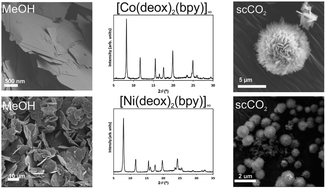Bottom-up approach for the preparation of hybrid nanosheets based on coordination polymers made of metal–diethyloxaloacetate complexes linked by 4,4′-bipyridine†
Abstract
In this work, three synthetic approaches were examined to obtain one dimensional (1D) coordination polymers with the formula [M(deox)2(bpy)]∞ (M = Co, Cu, Mn, Ni, Zn) (deox = diethyl oxaloacetate; bpy = 4,4′-bipyridine). These compounds precipitated as nanosheets arranged in different morphologies as a function of the medium used for the synthesis. Precursor [M(deox)2(H2O)x] (x = 1 for Cu, x = 2 for the other metals) molecular complexes were characterized by powder XRD. Besides, the 1H-NMR spectrum of the diamagnetic Zn(II) complex was measured, and the crystal structure of the Cu complex was elucidated to clarify the coordination mode of the deox ligand. These molecular complexes were used as the building blocks to prepare 1D coordination polymers, using 4,4-bipyridine as the organic linker. The first crystallization strategy involved the reaction between [M(deox)2(H2O)x] and bpy in methanol or ethanol. The second approach involved the use of the same reactants in supercritical CO2 (scCO2) and ethanol as a co-solvent (2% v/v). The third route required the previous preparation of [M(deox)2(tbpy)2]·nH2O adducts (tbpy = 4-tert-butylpyridine; n = 1 for Co, n = 2 for Cu and Zn, n = 1.5 for Mn and x = 0 for Ni) as scCO2 soluble precursors. The high solubility of these derivatives allowed the synthesis of the target coordination polymers in pure scCO2, i.e. avoiding the use of a co-solvent. All of the samples obtained from each strategy had a laminar morphology with nanometric thickness. The samples prepared using scCO2, independently of the use or not of a co-solvent, showed the formation of 15–60 nm thick flakes arranged in a desert rose type conformation. Those obtained using conventional liquid solvents had multiple, closely packed sheets of 40–80 nm thickness, with lateral dimensions in the order of tens of micrometers.



 Please wait while we load your content...
Please wait while we load your content...